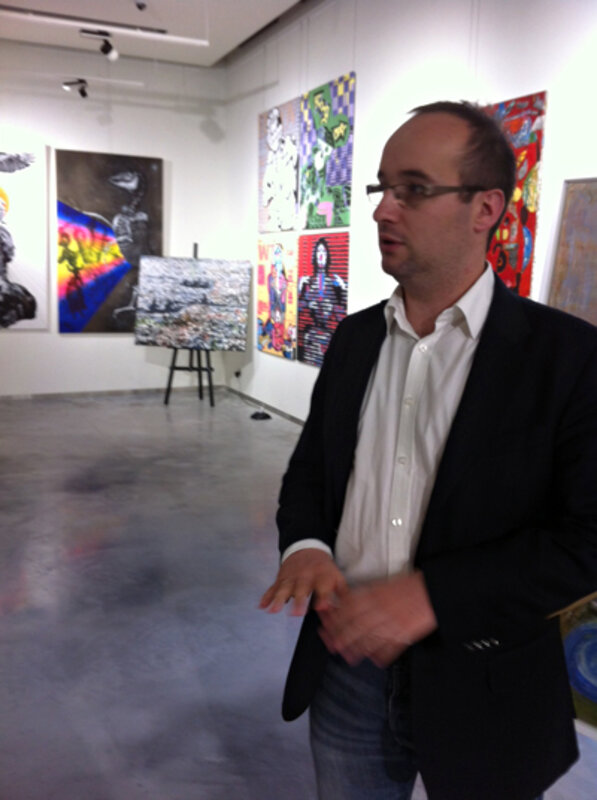Poland's art world moves out of the East and into the limelight
Loading...
| Warsaw
The contemporary art space Raster Gallery in Warsaw used to be tucked away up three flights of stairs in an old apartment complex.
Such venues aren’t atypical for the contemporary art galleries of post-Communist Poland. Exhibitions have been hung in hotel rooms, fire stations, or anywhere, really, that gallery owners and artists could find space.
So when Raster moved recently to a ground-level storefront with clearly marked opening hours to invite in the public, to the co-owner, at least, it felt as much symbolic as a matter of logistics. “We should be visible, there is no reason contemporary art should not be visible,” says Lukasz Gorczyca.
Apparently the outside world agrees. Polish art is the new buzz, with market research dedicating reports to its potential, new international exhibitions, and record sales of art pieces. It’s given rise to bold – if controversial – new experiments, and continues to grow with a middle-class collector base. While not altogether new, it’s left one thing clear.
“Poland is in vogue,” says Boguslaw Deptula, a leading art critic in Poland, who co-curated an exhibit called “Polish Art Now” at London’s Saatchi Gallery in June. “For many today, it’s ‘fancy’ to own a piece of [Polish] art.”
An art haven amid communism
Earlier this year, Skate’s Art Market Research, a company based in New York, published a report on Poland titled “The Rising Star of Central Europe,” and concluded its market is “innovative and quickly growing."
Mr. Gorczyca of Raster says that Poland is the hub of Central Europe right now in part because of simple numbers: it’s much larger than its neighbors. But history has played an important role too.
While there was vast censorship during communism in Central and Eastern Europe throughout the 20th century, Poland was given a degree of cultural autonomy. That meant that compared to neighboring countries such as Hungary or what is now the Czech Republic, he says, art was allowed to flourish.
Mr. Deptula says that contemporary art in particular fared well during the Soviet era. “For art, it wasn’t really a bad time,” he says, in a Warsaw gallery where he works as a manager. “Contemporary art was tolerated here. The Communist government preferred abstract art instead of realism,” he says, because there was less of an overt “political context.”
It’s been in the last decade that the genre has become more apparent, with a rise in contemporary gallery spaces and sales of contemporary art.
Gorczyca of Raster counts himself as a pioneer in the contemporary arts world in Warsaw. “When we started [the gallery], it was something that’s so simple, but the concept didn’t exist,” he says in his office in a neighborhood that is now dotted with Mediterranean and other ethnic eateries, cafes, and bars. At the time in 2001 there were doubts they could pull it off. “Artists said, ‘There is no market, there is no middle class,’” he says. “But we survived,” and he says their client base is growing.
That’s mostly among younger Poles drawn to newer art. Before 2000, it was the so-called “old masters” that accounted for almost 90 percent of the Polish market in terms of number of auction lots, reports Skate’s. In the first half of 2012, that share had dropped to 25 percent, while ultra-contemporary art, or art created by artists under 40 years old, increased its market share from 0.5 percent in 2005 to 43 percent in 2012, “making it the most dynamic segment of the Polish art market,” Skate's concludes.
Julia Michalska, London-based editor at The Art Newspaper, says that new galleries that have popped up recently are catering to the country's substantial middle-class collector base. These are not hugely wealthy patrons, but a growing “yuppie” class of lawyers and bankers who started their careers after the fall of communism in the 1990s and have benefited from one of Europe's steadiest economies.
Abbey House
One group has sought to capitalize on this – and has since become the most controversial part of Warsaw’s art scene today. Abbey House was begun in 2010. Its home is not in a fire house or crumbling apartment complex, but in a slick, modern shopping mall where stores sell designer labels – as well as $50 bottles of olive oil.
Abbey House is both gallery and auction house, and works with about a dozen artists, mostly young, who are put on a monthly salary in exchange for about three works of art per month. Notably it also promotes art as an asset with an investment fund.
It’s based on the fact that people are getting rich in Poland, says Maciej Gajewski, an economist and art market expert at Abbey House. “People are starting to think about new needs and interests,” he says. As new cafés and slow food movements pop up in Poland, so too are new tastes and motivations to spend money.
He acknowledges the criticism from galleries that say business and art shouldn’t mix. (Gorczyca doesn’t even count Abbey House as part of Poland’s contemporary art scene.) Local gallery owners also say the group is inflating the price of art and creating a bubble. One Abbey sale – a portrait by , in her 20s, of – went to a German buyer for more than $50,000.
Mr. Gajewski defends what Abbey House does. “People forget that artists need money,” he says.
Their larger drive is to promote a burgeoning art market in Poland. “Our idea is to give young people with their first money the opportunity to invest in art,” he says.
Whether young people in droves ultimately want to support art remains an open question. “I don’t think we have a big recognition of art in society,” says Anda Rottenberg, at the café of the Center for Contemporary Arts in Warsaw, housed in the Ujazdowski Castle.
“People can afford luxury cars but they don’t buy art. They don’t think it’s necessary.”





